There are few things more concerning as a homeowner than a roof leak. This leaves you scrambling to find the source and a solution before the dam breaks.
Unfortunately, there are plenty of reasons your roof could be leaking. It could be caused by improper installation, material failure, storm damage, and so much more.
However, there are common roof leaks we see and repair regularly. So, let's start there.
At Bill Ragan Roofing, we believe in using our 30-plus years in the roofing industry to help homeowners deal with stressful roof leaks. But even if we can't be there to physically help, we can still provide transparent and helpful information.
This article covers the following roof leaks and how to fix them:
- Pipe boot failure
- Improperly driven nails
- Roof flashing problems
- Debris in gutters that stop in a roof valley
- Chimney leaks
- Improperly installed or failing skylights
- Ice damming leaks
1. Pipe boot failure
The most common roof leak is pipe boot failure. A pipe boot (also called roof boot) is a type of roof flashing that goes around the base of the pipes coming through your roof.

Once a boot fails, you’ll have a roof leak over where the pipe is located on the roof, mainly a bathroom or closet. There are different types (lead, plastic, copper, etc.), but the most common is a neoprene (synthetic rubber) pipe boot. Unfortunately, they will not last the full life of the roof.
As the years pass, the neoprene gradually cracks due to constant exposure to UV rays from the sun. Once cracks form, it’s just a matter of time before water follows the pipe into your home.
This can take up to 10 years, but factors like location, weather, and animals determine how long they’ll actually last.
How do you fix a roof leak caused by pipe boot failure?
This is one of the easiest leaks to track because the leak shows up below the general roof area where the pipe is located. The simplest way to repair this roof leak is to install a rubber collar over the cracked neoprene pipe boot.
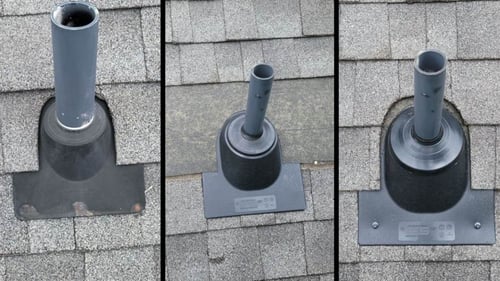
The collar encases the existing flange (flat rectangular flashing around the bottom of the pipe) and should last another 10 or so years. You can also fully replace the pipe boot, but this is a bigger repair requiring more expertise.
2. Improperly driven nails
The second most common roof leak is when nails back out through a shingle. Any nail that isn’t driven in far enough or driven in sideways eventually works its way up through the shingle.
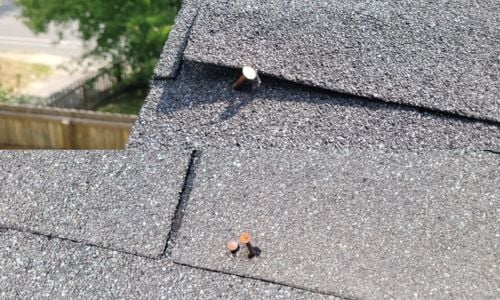
Once it’s through the shingle, water catches the nail's head and follows it into your home. While not as common, it can also happen to decking nails that didn’t hit wood.
However, you won’t have this problem if the nail hits good wood, holds tight and snug, and isn’t overdriven. Even though this roof leak is so common, you can avoid it by simply hiring a reputable roofing company that follows installation instructions and takes pride in their workmanship.
How do you fix a leaking roof caused by improperly driven nails?
Roof leaks from improperly driven nails can literally appear anywhere in your home. Depending on how many nail heads are sticking up, you could even have multiple roof leaks.
However, fixing this roof leak depends on what caused the nail to back out. To fix overdriven nails, a roofer breaks the seal on the shingle, lifts the shingle, pulls the nail out, moves it, and seals the old hole.
If the nail wasn’t driven in straight, they’ll pull the same nail out, drive it in properly, and lay some ice and water shield on top of it. In both instances, they’ll also reseal the shingle.
If the decking nail didn’t hit wood, the nail is moved over to catch the rafter before filling the hole with sealant to reseal the shingle back down.
3. Roof flashing problems
Roof flashing is metal that directs water away from certain areas on your roof. It’s one of the most important roofing components, and major leaks happen if flashing is missing, faulty, installed incorrectly, or has reached the end of its effectiveness.
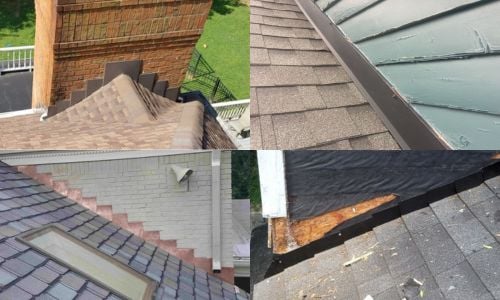
Roof leaks caused by roof flashing problems usually show up on the ceiling or down walls in areas where flashing is missing or not installed correctly. But while flashing is a general term, the area determines the type needed.
For leaks against a wall or chimney with wood or plastic siding, it’ll be step flashing. For leaks against a brick wall or chimney, it’ll be counter flashing.
For leaks around the base of walls, dormers, windows, skylights, and other penetrations where a roof vertically intersects the base, it’ll be apron flashing. No matter the type, compromised roof flashing lets a lot of water into your home.
How do you fix leaks caused by roof flashing problems?
Fixing roof flashing really depends on the extent of the issue. However, replacing compromised flashing is a big, complex, and expensive repair.
The shingles around the area need to be removed, rotten decking will be replaced, the old flashing is removed, ice and water shield is put down over the new decking, the new flashing is installed, before finally installing new shingles. If there’s siding, enough needs to be removed to access step flashing.
4. Debris in gutters that stop in a roof valley
A roof valley is when two roof slopes meet in a V shape for water to flow down to the gutters. While most valleys go to the gutter line, there are roofs where a gutter stops in the middle.
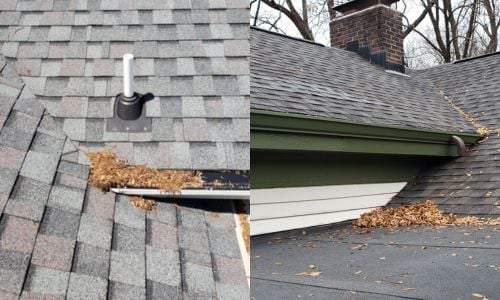
If this gutter gets filled with leaves and debris, water backs up and finds the path of least resistance to leak inside your home. This is especially true if there's no flashing applied to the fascia board (board that runs along the eaves/gutter line).
If this is the case, it's not if it'll leak, it's when. Once water gets behind the gutter, it can go anywhere before showing up in a room, walls, or wherever the gutter is.
How do you fix roof leaks caused by a gutter stopping in a valley?
The roof leak is repaired by simply adding flashing to stop water from getting behind the gutter. This is done by loosening the gutter and installing three pieces of flashing behind the gutter and on the roof, with the last piece tucked under the valley.
Just know you can avoid leaks by keeping your gutters and roof clear of debris. Neglecting this form of roof maintenance makes this roof leak more likely.
5. Chimney leaks
One of the most common leaks we get calls for is around a chimney. If it’s a roof leak, it’s usually caused by problems with the flashing under the shingles surrounding the chimney.
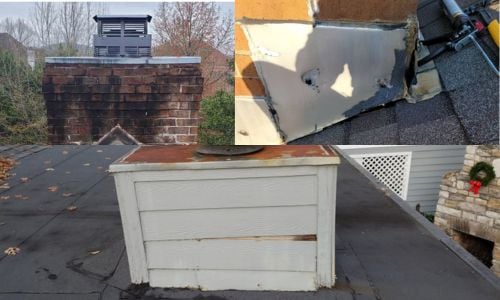
However, there are plenty of chimney leaks that aren’t necessarily roof leaks. If it rains for a few days, the mortar joints and bricks on a brick chimney can become so saturated that water can get into the ceiling and walls around the fireplace.
If water drips into your fireplace when it rains, it’s a problem with the chimney cap or top. If you have a chimney with siding, water can get in at the corners to rot the outside boards and the wood behind the chimney you can’t see.
How do you fix chimney leaks?
Fixing a chimney leak depends on the problem. If the leak is from flashing problems, the roofer will reflash the area around it like a normal flashing repair.
If it’s from the mortar joints, they’ll have to apply a masonry water repellent to seal it. To repair leaks from chimney siding, you'll actually have to hire a competent carpenter or siding man.
For leaks through a chase top, you need to find a licensed chimney sweep company. Most roofers don't have the proper licenses and, more importantly, the insurance to do this kind of work.
6. Improperly installed or failing skylights
There’s a misconception that all skylights leak. However, this roof leak usually only happens because a skylight component fails or it was improperly installed.
If the installer does not read and follow the manufacturer’s installation instructions, it’s guaranteed to let water in. But how the water gets in determines the damage it causes.
If it's from a problem with the flashing, the roof leak damages the drywall around the skylight. If it's a problem with a component or a piece of the skylight, water drips on whatever is below.
How do you fix a roof leak caused by an improperly installed or failing skylight?
Repairing a skylight depends on what’s causing the leak. To fix flashing issues, the cladding and flashing kit are taken off, ice and water shield is put around it, and then the flashing kit is put back on to make a watertight seal.
If it’s leaking because of improper installation, you just need to have the skylight or certain component(s) reinstalled correctly. But if your skylight is failing due to age or the factory seal has reached the end, you’ll have to pay for a replacement to truly stop the leak.
7. Ice damming leaks
Anytime there’s a snow or ice storm, I guarantee roofing companies get calls about ice damming leaks. Ice dams form on a roof when snow and ice freeze down by the gutter line (eaves) or in roof valleys that create a literal dam of ice.
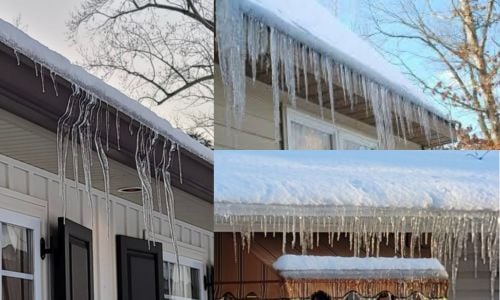
When the ice and snow above the ice dam start to melt, water backs up, gets under the roofing material, and leaks into your home until it completely thaws out. There’s usually a lot of water, so make sure you have a bucket to catch the water coming into your home.
How do you prevent roof leaks caused by ice damming?
Unfortunately, there’s nothing a roofer can do to stop leaks caused by ice damming when it’s already happening. However, there are things you can do to prevent ice dam leaks next time you replace your roof.
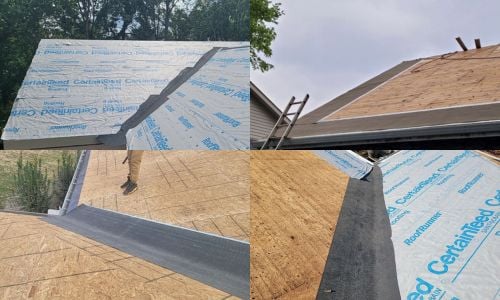
One way is to install ice and water shield around the edges (rakes and eaves) of your roof 2 feet past the interior walls of your home. If you can’t afford to do it at the edges, you can install ice and water shield in your roof valleys.
If you have a deadpan valley, you need metal or a membrane installed in the valley and/or against the wall to prevent water from seeping into cracks.
How much will it cost to repair your roof leak?
After reading this article, you know the most common roof leaks, where they'll show up, and how they're repaired. I know DIY work has increased significantly over the past few years.
And I understand wanting to do your own repairs, especially from a cost-saving perspective. But before jumping on YouTube and heading to Home Depot to fix a leak, you need to know how much roof repairs actually cost.
The last thing you want is to do more damage or hurt yourself to save a couple hundred dollars. That's why I wrote another article breaking down the cost of repairing a roof professionally.
Check out How Much It Costs to Repair a Roof Leak to learn the average cost, plus pricing for some of the common repairs we covered and what impacts the cost.



